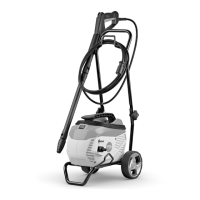■ At temperatures below 0° C water can freeze
in the components of the pressure washer.
The pressure washer may be damaged.
►
Drain high-pressure hose and spray attach‐
ment.
► If the pressure washer cannot be
protected from frost in transport:
Protect the pressure washer with
glycol-based antifreeze.
4.12 Storage
WARNING
■ Children are not aware of and cannot assess
the dangers of the pressure washer. Children
can be seriously injured.
►
Lock spray gun trigger.
► Switch off pressure washer.
► Unplug the mains plug of the pressure
washer from the socket.
► Store the pressure washer out of the reach
of children.
■ Moisture may cause the electrical contacts on
the pressure washer and metal components to
corrode. The pressure washer may be dam‐
aged.
►
Store the pressure washer in a clean, dry
state.
■ At temperatures below 0 °C water may freeze
in components of the pressure washer. The
pressure washer may be damaged.
►
Drain high-pressure hose and spray attach‐
ment.
► If the pressure washer cannot be
stored in a frost-free environment:
Protect the pressure washer using
a glycol-based antifreeze.
4.13 Cleaning, Maintenance and
Repair
WARNING
■
If the mains plug is plugged into a socket
when carrying out cleaning, servicing or
repairs, it is possible that the high-pressure
washer may be switched on inadvertently.
This may result in serious injury to people and
damage to property.
►
Lock the spray gun trigger.
► Switch off the high-pressure washer.
► Unplug the mains plug of the high-pressure
washer from the socket.
■ Harsh detergents, cleaning with a water jet or
sharp objects can damage the high-pressure
washer. If the high-pressure washer is not
properly cleaned, parts may not function prop‐
erly and safety devices can be disabled. They
may cause serious injury to persons.
►
Always clean the high-pressure washer as
described in this user manual.
■ If the high-pressure washer is not properly
serviced or repaired, parts may not function
properly and safety devices can be disabled.
This may result in serous or fatal injury to peo‐
ple.
►
Do not attempt to service or repair the high-
pressure washer yourself.
► If the connecting cable is faulty or dam‐
aged: Have the connecting cable replaced
by a STIHL dealer.
►
If the high-pressure washer needs to be
serviced or repaired: Contact a STIHL
dealer.
5 Preparing the pressure
washer for operation
5.1 Making the pressure washer
ready for use.
The following steps must be performed before
commencing work:
► Make sure that the pressure washer, the high-
pressure hose, the hose coupling and the con‐
necting cord are in a safe condition,
4.6.
►
Cleaning the pressure washer,
14.
► Set the high-pressure washer on a firm and
level base, where it will not slide or tip over.
►
Attach the handlebar, 6.1.
►
Unfold the handlebar, 6.2.1.
►
Connect the high-pressure hose, 6.3.
►
Connect spray gun, 6.4.
►
Fit spray lance, 6.5.
►
Attach nozzle, 6.6.
►
If using a detergent: Using detergents,
10.4.
► Connect high-pressure washer to a water
source, 7.
►
Connect pressure washer to power supply,
8.
► If it is not possible to carry out these steps: Do
not use the pressure washer. Consult a STIHL
servicing dealer.
English 5 Preparing the pressure washer for operation
10 0458-016-0101-A

